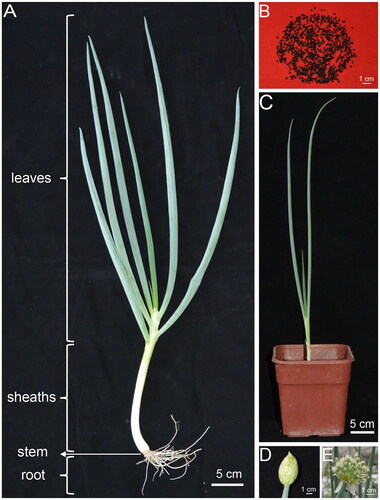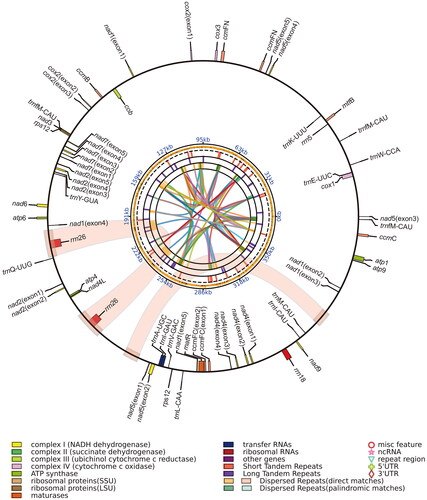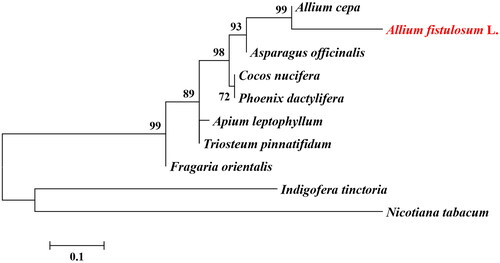Abstract
Allium fistulosum L. (Linnaeus, Carolus, 1753) is an aromatic vegetable with health benefits and medicinal value. In this study, the complete mitochondrial genome of A. fistulosum was determined. Circular mitochondrial DNA (mtDNA) was 382,053 bp in size, encoded 44 genes, and contained 26 protein-coding genes (PCGs), 14 tRNAs, and four rRNAs. Phylogenetic analysis of amino acid sequences of the 26 PCGs revealed that the closest relationship was between A. fistulosum and Allium cepa. The high-quality mitochondrial genomic sequences of A. fistulosum presented in this study will serve as a useful resource for a range of genetic, functional, evolutionary, and comparative genomic studies on this species of the Amaryllidaceae family.
Introduction
Allium fistulosum L. (Linnaeus, Carolus, 1753) is a perennial herb belonging to the family Amaryllidaceae that is widely distributed in Asia (Singh and Ramakrishna Citation2017). A. fistulosum is a typical spicy vegetable, is an excellent flavoring agent in dietary cooking and plays an important role in preventing human diseases (Gao et al. Citation2022; Tang et al. Citation2022).
The mitochondrial genome contains genetic and evolutionary information about the species, and its high conservation in eukaryotes makes it a useful marker for evolutionary research (Zheng et al. Citation2018). To date, only the complete mitochondrial genome of Allium cepa has been published in the Amaryllidaceae family (Kim et al. Citation2016), and there is no information on the mitochondrial genome of A. fistulosum. To our knowledge, this is the first study to report the complete mitochondrial genome of A. fistulosum.
Materials and methods
In the present study, fresh leaf sample of A. fistulosum were collected from the Beijing Vegetable Research Center of the Beijing Academy of Agricultural and Forestry Sciences (BVRC), Beijing, China (11°54′55″ E, 40°21′58″ 36 N) (). The voucher specimen was deposited in the Germplasm Resource Bank of the BVRC under voucher number 31310 (contact person: Yongqin Wang; [email protected]). Leaf mitochondrial DNA was extracted as previously described by Chen et al. (Citation2011). Purified DNA was sequenced on an Illumina Hiseq 4000 and PacBio, assembled in SPAdes v3.10.1 (Borgström et al. Citation2011). Geseq (https://chlorobox.mpimp-golm.mpg.de/geseq.html) was used to annotate the mitochondrial genome. OrganelleGenomeDRAW software (OGDRAW) was used to map the mitochondrial genome (Greiner et al. Citation2019). The complete mitogenome sequences of the nine species were downloaded from GenBank and aligned using the MAFFT website (Katoh and Standley 2013). Phylogenetic analyses were performed using MEGA 6 with 1000 bootstrap replicates, and the model-finding tool in MEGA 6 was used to acquire the best replacement model. During this process, maximum likelihood analysis was performed, and the cpREV model was chosen as the appropriate model for sequencing, with Indigofera tinctoria (MW448462) and Nicotiana tabacum (NC_006581) considered as outgroups. Primers for the identification of the cox2 gene were referred to Kim et al. (Citation2013).
Figure 1. Species reference map and pictures of the growth and development process of Allium fistulosum. (A) Whole plant of A. fistulosum. A. fistulosum is a monocotyledonous plant with green tubular leaves. Pseudostems are formed by metamorphic development of leaf sheaths. The stem is extremely shortening. The root system is fibrous roots with strong regenerative ability. (B) Seeds. The seeds are black, shield-shaped, with a raised, angular back and a semicircular abdomen; (C) Seedling. The seedling is of elongated tubular leaf young leaves that are light green. (D) Unopened flower bud. The unopened buds are covered with a membrane; E: Blooming bud. The apical umbellate florets are spherically clustered and arranged radially. These photos were taken by the author of Jiayi Xing.

Results
The mitochondrial genome of A. fistulosum was sequenced to an average depth of 1207 X (supplemental Figure S1), indicating that it could be used for subsequent bioinformatic analysis of the mitochondrial genome. The total mitochondrial genome length of A. fistulosum was 382,053 bp (GenBank accession number OL347690), with a GC content of 44.98%. It consisted of 26 protein-coding genes (PCGs) (atp1, atp4, atp6, atp9, ccmB, ccmC, ccmFN1, ccmFN2, ccmFC, cob, cox1, cox2, cox3, matR, mttB, nad1, nad2, nad3, nad4, nad4L, nad5, nad6, nad7, nad9, and two rps12), 14 tRNA genes, and 4 rRNA genes (). All PCGs used ATG as the start codon, except for cox1, nad1, nad4L, and rps12, for which the start codons were GTG, ACG, ACG and ACT, respectively. The 14 tRNA-coding genes ranged in size from 67 bp to 83 bp (). With regard to stop codons, three PCGs (atp6, atp9, and ccmFC) were terminated with CAA or CGA, whereas the remaining 23 PCGs were terminated with routine termination codons (TAA, TAG, or TGA). Gene annotation prediction results showed that the genome contained 3 cis-splicing genes (ccmFC, nad4, and nad7) and 4 trans-splicing genes (cox2, nad1, nad2, and nad5) (). And the PCR identification result of the cox2 in Asparagus, A. cepa and A. fistulosum also showed that cox2 was trans-splicing (supplemental Figure S4), which was similar to the findings of Kim et al. (Citation2013). Additionally, the phylogenetic analysis showed that A. fistulosum was closely related to A. cepa, followed by Asparagus officinalis ().
Figure 2. Mitochondrial genome map of Allium fistulosum, with 26 protein-coding genes (PCGs), 14 tRNAs, and four rRNAs. The rRNAs genes were filled in red, and genes with related functions are shown in the same color. Genes that are found in the inner and outer circle are transcribed clockwise and counterclockwise, respectively. The colored parabola in the center circle represents the dispersed repeats.

Figure 3. A maximum-likelihood (ML) tree was constructed based on ten species of mitochondrial genomes (mtDNA) with 1000 bootstrap replicates, with Indigofera tinctoria (MW448462) and Nicotiana tabacum (NC_006581) as outgroups. The newly sequenced species in this study is indicated in red. The following sequences were used: A. cepa AP018390 (Shigyo et al. Citation2018), Asparagus officinalis NC_053642 (Sheng Citation2020), Cocos nucifera NC_031696 (Aljohi et al. Citation2016), Phoenix dactylifera NC_016740 (Fang et al. Citation2012), Apium leptophyllum MZ328723, Triosteum pinnatifidum NC_064333, Fragaria orientalis NC_057524 (Liu et al. Citation2021), Indigofera tinctoria MW448462 (Choi et al. Citation2021), Nicotiana tabacum NC_006581 (Sugiyama et al. Citation2005). NCBI accession numbers are given for Genbank sequences.

Table 1. Gene information of the mitochondrial genome of A. fistulosum.
Discussion and conclusion
There are over 900 species in the genus Allium (Yang et al. Citation2023). Given the huge genome, molecular biology research on A. fistulosum has progressed slowly compared to that on other crops. Liao et al. (Citation2022) published the genome of A. fistulosum, with a size of 11.27 Gb and pointed that A. fistulosum was the closest relative to A. cepa. In the present study, we assembled and analyzed the complete mitochondrial genome of A. fistulosum and found that A. fistulosum and A. cepa have a close genetic relationship. Not only that, the PCR identification result showed that cox2 gene in mitochondrial genome of A. fistulosum was trans-splicing, which further proof that A. fistulosum are closely related to A. cepa (Kim et al. Citation2013). The complete mitochondrial genome of A. fistulosum was reported for the first time. Our study lays the foundation for the study of the mitochondrial genome of the Allium genus and contributes to the identification and genetic, evolutionary, and functional studies of Amaryllidaceae species.
Author contributions
Jiayi Xing and Yongqin Wang designed the experiments, analyzed the data and wrote the manuscript. Mingzhao Zhu and Huiying Liu revised the manuscript and approved the version to be published. All authors agree to be accountable for all aspects of the work.
Ethical statement
The research and collection of plant material was carried out according to the guidelines of the Beijing Vegetable Research Center, Beijing Academy of Agricultural and Forestry Sciences. This study includes no endangered plant samples, and the sampling site is not located in any protected area.
Supplemental Material
Download JPEG Image (152.2 KB)Supplemental Material
Download JPEG Image (2.9 MB)Supplemental Material
Download JPEG Image (2.2 MB)Supplemental Material
Download JPEG Image (264.8 KB)Disclosure statement
No potential conflict of interest was reported by the author(s).
Data availability statement
The results of this study are authentic and effective, and the genome sequence data are publicly available in NCBI (https://www.ncbi.nlm.nih.gov/) under the accession number OL347690. The associated BioProject, SRA, and Bio-Sample numbers are PRJNA782797, SRR17015068, and SAMN23401061, respectively.
Additional information
Funding
References
- Aljohi H, Liu W, Lin Q, Zhao Y, Zeng J, Alamer A, Alanazi I, Alawad A, Al-Sadi A, Hu S, et al. 2016. Complete sequence and analysis of coconut palm (Cocos nucifera) mitochondrial genome. PLoS One. 11(10):e0163990. doi:10.1371/journal.pone.0163990.
- Borgström E, Lundin S, Lundeberg J. 2011. Large scale library generation for high throughput sequencing. PLoS One. 6(4):e19119. doi:10.1371/journal.pone.0019119.
- Chen J, Guan R, Chang S, Du T, Zhang H, Xing H. 2011. Substoichiometrically different mitotypes coexist in mitochondrial genomes of Brassica napus L. PLoS One. 6(3):e17662. doi:10.1371/journal.pone.0017662.
- Choi IS, Wojciechowski MF, Ruhlman TA, Jansen RK. 2021. In and out: evolution of viral sequences in the mitochondrial genomes of legumes (Fabaceae). Mol Phylogenet Evol. 163:107236. doi:10.1016/j.ympev.2021.107236.
- Fang Y, Wu H, Zhang T, Yang M, Yin Y, Pan L, Yu X, Zhang X, Hu S, Al-Mssallem I, et al. 2012. A complete sequence and transcriptomic analyses of date palm (Phoenix dactylifera L.) mitochondrial genome. PLoS One. 7(5):e37164. doi:10.1371/journal.pone.0037164.
- Gao S, Wang K, Li N, Lv Y, Cao B, Chen Z, Xu K. 2022. The growth and photosynthetic responses of white LEDs with supplemental blue light in green onion (Allium fistulosum L.) unveiled by Illumina and single-molecule real-time (SMRT) RNA-sequencing. Environ Exp Bot. 197:104835. doi:10.1016/j.envexpbot.2022.104835.
- Greiner S, Lehwark P, Bock R. 2019. OrganellarGenomeDRAW (OGDRAW) version 1.3. 1: expanded toolkit for the graphical visualization of organellar genomes. Nucleic Acids Res. 47(W1):W59–W64. doi:10.1093/nar/gkz238.
- Katoh K, Standley DM. 2013. MAFFT multiple sequence alignment software version 7: improvements in performance and usability. Mol Biol Evol. 30(4):772–780. doi:10.1093/molbev/mst010.
- Kim B, Kim K, Yang TJ, Kim S. 2016. Completion of the mitochondrial genome sequence of onion (Allium cepa L.) containing the CMS-S male-sterile cytoplasm and identification of an independent event of the ccmFN gene split. Curr Genet. 62(4):873–885. doi:10.1007/s00294-016-0595-1.
- Kim S, Bang H, Patil B. 2013. Origin of three characteristic onion (Allium cepa L.) mitochondrial genome rearrangements in Allium species. Sci Hortic. 157:24–31. doi:10.1016/j.scienta.2013.04.009.
- Liao N, Hu Z, Miao J, Hu X, Lyu X, Fang H, Zhou Y, Mahmoud A, Deng G, Meng Y, et al. 2022. Chromosome-level genome assembly of bunching onion illuminates genome evolution and flavor formation in Allium crops. Nat Commun. 13(1):6690. doi:10.1038/s41467-022-34491-3.
- Liu HB, Sun J, Sun R, Li ST, Zhong CF, Dong J, Chang LL, Wang GX, Zhang HL, Wei YQ, et al. 2021. The complete mitochondrial genome sequence of Fragaria orientalis (Rosaceae). Mitochondrial DNA B Resour. 6(7):1951–1952. doi:10.1080/23802359.2021.1920498.
- Sheng W. 2020. The complete mitochondrial genome of Asparagus officinalis L. Mitochondrial DNA B Resour. 5(3):2627–2628. doi:10.1080/23802359.2020.1780986.
- Shigyo M, Khar A, Abdelrahman M. 2018. The Allium genomes. Cham: Springer.
- Singh B, Ramakrishna Y. 2017. Welsh onion (Allium fistulosum L.): a promising spicing-culinary herb of Mizoram. Indian J Hill Farming. 30:201–208.
- Sugiyama Y, Watase Y, Nagase M, Makita N, Yagura S, Hirai A, Sugiura M. 2005. The complete nucleotide sequence and multipartite organization of the tobacco mitochondrial genome: comparative analysis of mitochondrial genomes in higher plants. Mol Genet Genomics. 272(6):603–615. doi:10.1007/s00438-004-1075-8.
- Tang W, Wang G, Chen R, Liu X, Chen X, Shen X, Yin C, Mao Z. 2022. Allium fistulosum L. alleviates apple replant disease by suppressing Fusarium solani. JoF. 8(10):1071. doi:10.3390/jof8101071.
- Yang J, Kim SH, Gil HY, Choi HJ, Kim SC. 2023. New insights into the phylogenetic relationships among wild onions (Allium, Amaryllidaceae), with special emphasis on the subgenera Anguinum and Rhizirideum, as revealed by plastomes. Front Plant Sci. 14:1124277. doi:10.3389/fpls.2023.1124277.
- Zheng B, Cao L, Tang P, Achterberg K, Hoffmann A, Chen H, Chen X, Wei S. 2018. Gene arrangement and sequence of mitochondrial genomes yield insights into the phylogeny and evolution of bees and sphecid wasps (Hymenoptera: Apoidea). Mol Phylogenet Evol. 124:1–9. doi:10.1016/j.ympev.2018.02.028.
